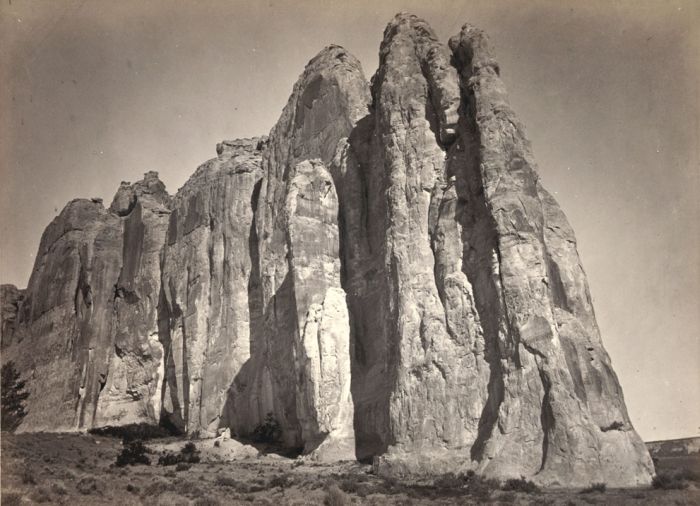History: American Old West, United States
|
Building the railroad required six main activities: surveying the route, blasting a right of way, building tunnels and bridges, clearing and laying the roadbed, laying the ties and rails, and maintaining and supplying the crews with food and tools. The work was highly labor intensive, using mostly plows, scrapers, picks, axes, chisels, sledgehammers, and handcarts. A few steam-driven machines, such as shovels, were employed as well. Each iron rail weighed 700 lb (320 kg). and required five men to lift. For blasting, they used gunpowder, nitroglycerine, and limited amounts of dynamite. The Central Pacific employed over 12,000 Chinese workers, 90 percent of the work force. The Union Pacific employed mostly Irishmen. The crews averaged about two miles (3 km) of new track per day but they were driven to do more. Each man lifted a few tons a day of weight. In the haste to complete the project, engineering errors caused collapsing roadbeds and badly graded curves. Substandard rails and ties were also serious problems. The defects became even more apparent with freight runs, causing many accidents, and the line eventually required millions of dollars to repair and replace bad track.
With grants and loans, the federal government stimulated the land and capital acquisition needed for the project. Leland Stanford, former governor and part of a group of businessmen known as the "Big Four", sold stock and bonds in the enterprise to finance construction, with the help of Wall Street money men like Jay Gould who connected with investors in the United States and Europe. The enterprise was considered risky, given the high construction costs, and the bonds need to yield high interest (similar to today's "junk bonds") to be attractive to investors. The huge dollars involved in the project and the participation of so many groups out to profit resulted in substantial corruption and influence peddling. The owners of both construction companies, using mostly "other people's money", insured their own profits with shady dealing and with slush funds used to bribe government officials.
The worst corruption revolved around George Francis Train's Crédit Mobilier, the construction company for the Union Pacific, which, according to author Richard White, drew in "dozens of congressmen, a secretary of the treasury, two vice-presidents, a leading presidential contender, and an eventual president. It caused a scandal that remained an issue in four presidential elections". Train's other enterprises, including the Credit Foncier of America, Train Town and Omaha's Cozzens Hotel, succeeded, further burnishing Train's image. While the Central Pacific-Union Pacific railroad succeeded, other transcontinental projects failed to reach the Pacific coast until many years later. The most notorious was the Northern Pacific project which failed to sell its bonds, resulting in the collapse of the Jay Cooke & Company investment house and helping to trigger the financial Panic of 1873. The most profitable of the transcontinental lines was the Great Northern railroad which ran along the northern tier of the United States, providing freight service to the Northwest. The cost of moving freight on the Great Northern was 2.88 cents per ton early on, falling to less than 0.80 cents by 1907.
Despite the engineering problems and political scandals, the transcontinental railroad was a big success in helping to open up the West. In the first year, 150,000 passengers made the trip for "pleasure, health, or business" and enjoyed the "luxurious cars and eating houses" as advertised by the Union Pacific. Settlers were encouraged with promotions to come West on scouting trips to buy land near the line and to use the rails for freight needs. The railroads had "Immigration Bureaus" which advertised the "promised land" abroad. Railroad "Land Departments" sold land on easy terms. The Great Plains, a harder "sell" than California or Oregon, was promoted as "prairie which is ready for the plow" and "a flowery meadow" only requiring "diligent labor and economy to ensure an early reward."
|
|









